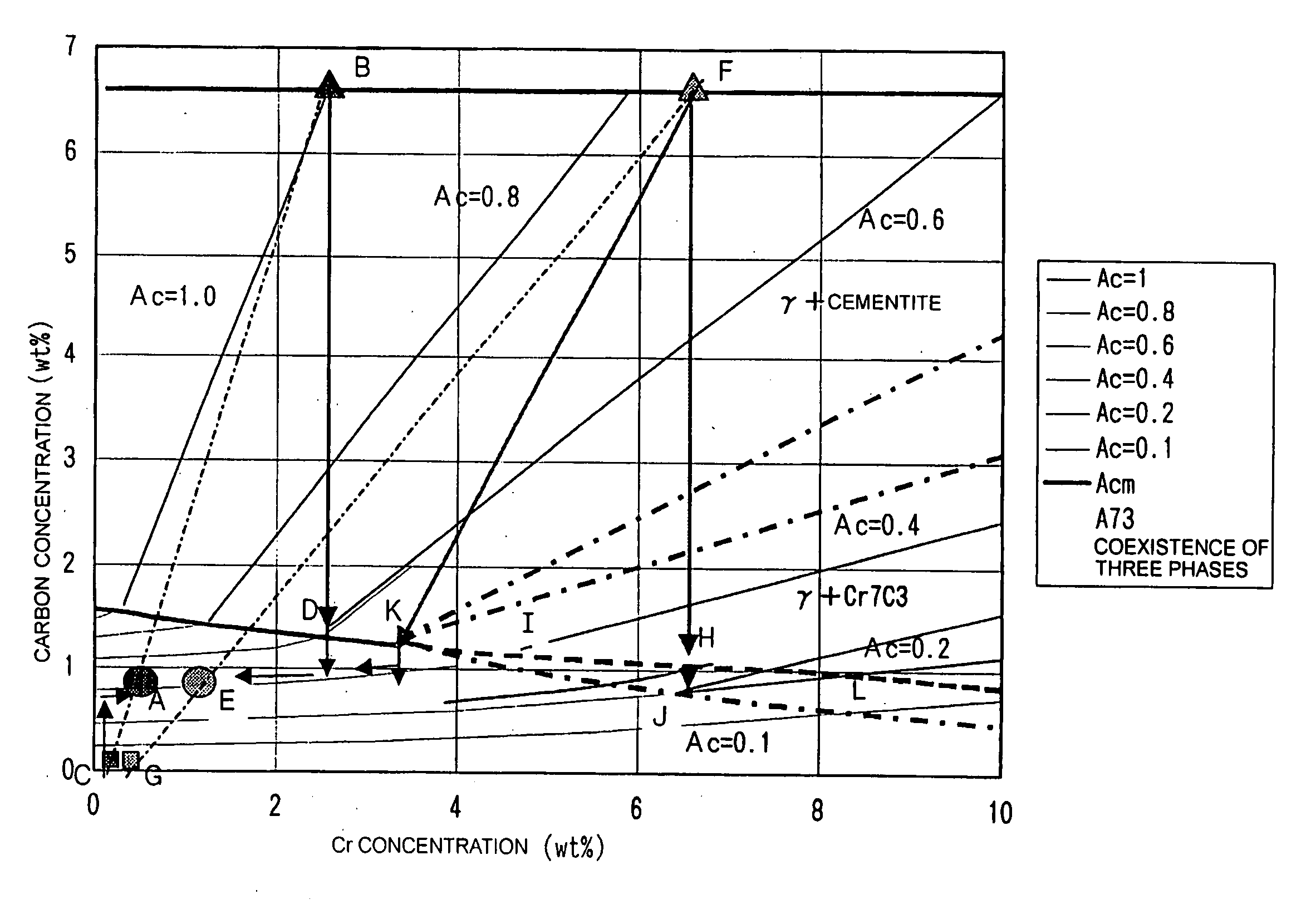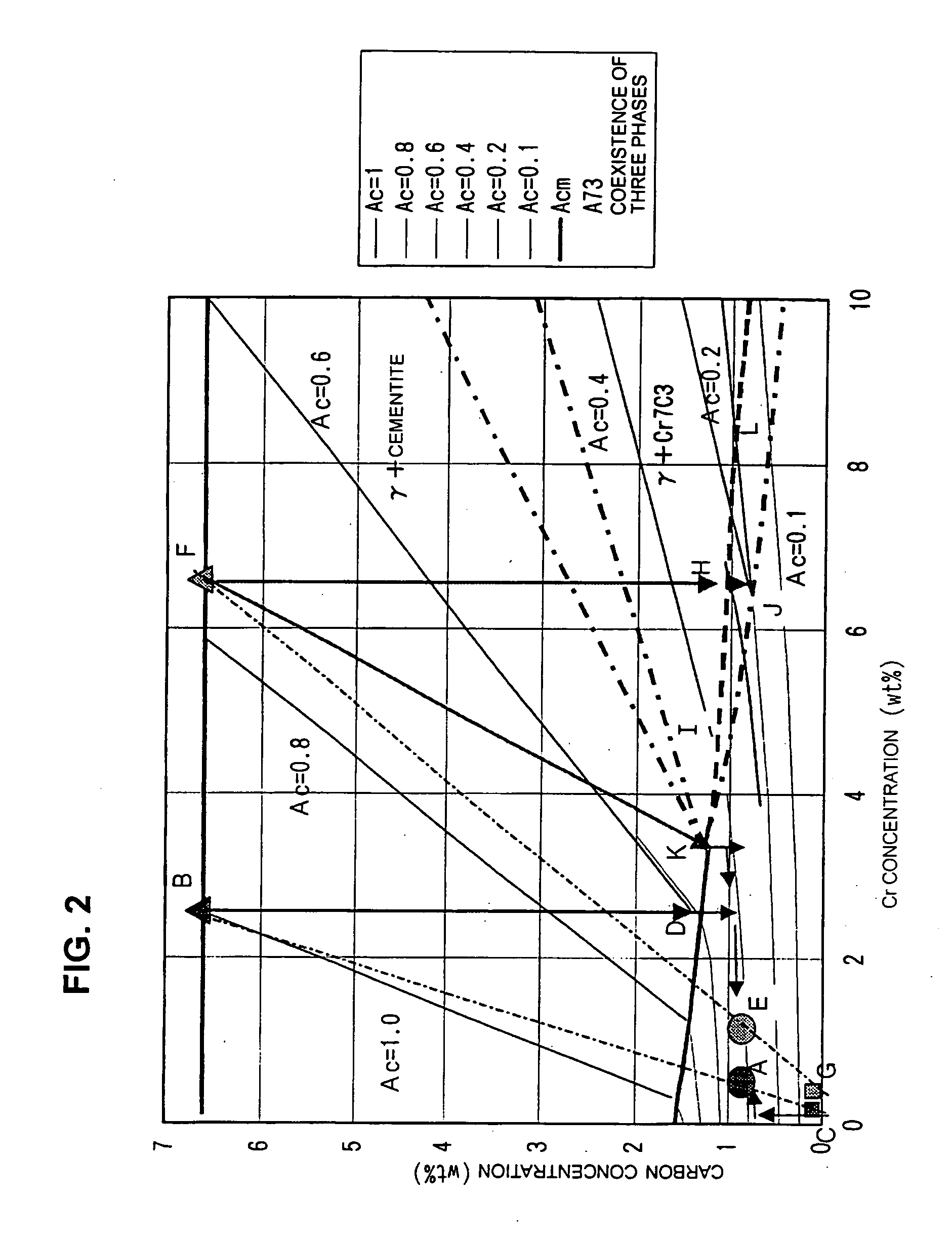Rolling element and method of producing the same
a technology of rolling element and rolling element, which is applied in the direction of metallic material coating process, solid-state diffusion coating, portable lifting, etc., can solve the problems of affecting the economic efficiency of machining of gears, and affecting the economic efficiency of machining. , to achieve the effect of improving the economic efficiency, improving the bending fatigue strength and pitting resistance of the surface layer of the rolling element, and improving the economic efficiency of machining
- Summary
- Abstract
- Description
- Claims
- Application Information
AI Technical Summary
Benefits of technology
Problems solved by technology
Method used
Image
Examples
example 1
The pitting resistance of quenched, tempered carbon steels and carburized, quenched, case-hardened steels
(Preliminary Test)
[0111] In this example, a roller pitting test was conducted using the test specimens shown in FIG. 4 and various, quenched, tempered carbon steels and carburized, quenched, case-hardened steels were checked in terms of pitting resistance to investigate the rolling fatigue strength of the tooth flanks of gears under a sliding contact condition. Table 1 shows the chemical compositions of the various carbon steels and case-hardened steels used in this example. These steel materials were respectively shaped into the small rollers shown in FIG. 4(a) and the test specimens No. 1, 2 and 4 were further subjected to water quenching after heating at 820° C. for 30 minutes, and then tempered at 160° C. for 3 hours, followed by testing. The test specimen Nos. 3 and 4 were quench-hardened, at their rolling contact surfaces, using a 40 kHz high-frequency power source after...
example 2
Checking of Temper Softening Resistance
[0117] Table 2 shows the alloy compositions employed in this example. Thermal treatment was carried out in such a way that after heated at 810 to 870° C. for 30 minutes, each test specimen was subjected to water cooling and then tempering at 300° C. and 350° C. for 3 hours. Thereafter, the Rockwell hardness HRC of each test specimen was checked and the effect of addition of each alloy element on the hardness was analyzed.
TABLE 2TPNo.CSiAlMnNiCrMoVBNo. 60.451.450.461.490.520.140.0018No. 70.491.450.461.011.030.150.0019No. 80.470.310.462.011.030.150.0019No. 90.490.290.451.51.490.230.0019No. 100.361.770.60.620.110.0026No. 110.450.950.660.011.290.50.0029No. 120.390.931.020.080.970.950.5No. 130.430.260.441.010.480.001No. 140.470.250.41.011.050.0018No. 150.461.50.410.510.002No. 160.450.240.41.020.480.310.0011No. 170.451.460.390.960.980.001No. 180.410.250.3510.490.0017No. 190.522.30.570.11No. 200.980.270.481.47No. 210.550.230.71No. 220.770.210.74No....
example 3
An Improvement in Pitting Resistance by Use of Steel Material Having Excellent Temper Softening Resistance—1
[0122] Table 3 shows the alloy compositions of the steel materials used in this example. After induction hardened under the same induction heating condition as in Example 1, each test specimen was tempered at 160° C. for 3 hours and then subjected to a roller pitting test.
TABLE 3VOLUMEINTERFACEPERCENT OFPRESSURE THATCSiAlMnNiCrMoVTiCEMENTITECAUSES SEIZURENo. P10.580.210.0240.410.462350No. P20.630.580.0210.380.462350No. P30.610.251.470.930.981.040.353400No. P40.831.010.310.550.960.385375No. P50.730.710.0280.460.490.194425SCM420 + GCQT300SCM440 + QT275SUJ2 + QT400S55C + QT275
[0123] The dispersion amount of the cementite contained in the rolling contact surface layer of each test specimen is also written in Table 3. The test for checking pitting resistance was carried out under substantially the same condition as in Example 1 and the test result is shown in FIG. 8. The pitting...
PUM
| Property | Measurement | Unit |
|---|---|---|
| particle diameter | aaaaa | aaaaa |
| average particle diameter | aaaaa | aaaaa |
| average particle diameter | aaaaa | aaaaa |
Abstract
Description
Claims
Application Information
 Login to View More
Login to View More - R&D
- Intellectual Property
- Life Sciences
- Materials
- Tech Scout
- Unparalleled Data Quality
- Higher Quality Content
- 60% Fewer Hallucinations
Browse by: Latest US Patents, China's latest patents, Technical Efficacy Thesaurus, Application Domain, Technology Topic, Popular Technical Reports.
© 2025 PatSnap. All rights reserved.Legal|Privacy policy|Modern Slavery Act Transparency Statement|Sitemap|About US| Contact US: help@patsnap.com



